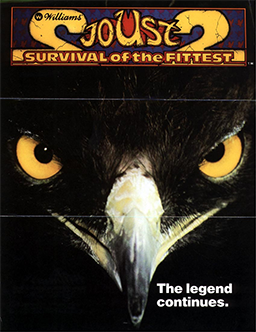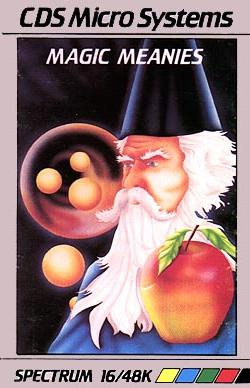
The NewZealand Story is a platform game developed and released in arcades by Taito in 1988. The concept and setting were inspired by a holiday trip in New Zealand by one of the Taito programmers. The player controls Tiki (ティキ), a kiwi who must save his girlfriend Phee Phee (ピューピュー) and several of his other kiwi chick friends who have been kidnapped by a large blue leopard seal. While avoiding enemies, the player has to navigate a scrolling maze-like level, at the end of which they release one of Tiki's kiwi chick friends trapped in a cage. In 2007, the arcade game received a remake for the Nintendo DS under the title New Zealand Story Revolution.

Joust is an action game developed by Williams Electronics and released in arcades in 1982. While not the first two-player cooperative video game, Joust's success and polished implementation popularized the concept. Players assume the role of knights armed with lances and mounted on large birds, who must fly around the screen and defeat enemy knights riding buzzards.

Double Dragon II: The Revenge is a side-scrolling beat 'em up produced by Technōs Japan originally released as a coin-operated arcade game in 1988. It is the first sequel to Double Dragon, released during the previous year. The sequel involves Billy and Jimmy Lee in a mission to avenge Billy's girlfriend Marian after she is shot to death by the Black Warriors leader Willy, who is retaliating against the Lee brothers after his defeat at the end of the previous game. Double Dragon II was initially developed as an upgrade kit for the original Double Dragon, but evolved into a stand-alone game due to an increase in memory size, resulting in the developers reusing assets for both games.

Ikari Warriors, known as Ikari in Japan, is a vertically scrolling run and gun video game released for arcades by SNK in 1986. It was published in North America by Tradewest. At the time there were many Commando clones on the market. What distinguished Ikari Warriors were rotary joysticks and a two-player cooperative mode. The rotary joystick controls were in turn based on SNK's earlier TNK III (1985). Ikari was originally intended to be an official licensed adaptation of the film Rambo: First Blood Part II (1985), but SNK were initially unable to acquire the rights to the film.

Nekketsu Kōha Kunio-kun, released as Renegade in the West, is a beat 'em up video game developed by Technōs Japan and distributed by Taito for the arcades in 1986. In the original Japanese version Nekketsu Kōha Kunio-kun, the game revolves around a high-school delinquent named Kunio-kun who must stand up against a series of rival gangs frequently targeting his classmate Hiroshi. In the Western version Renegade, the player controls a street brawler who must face four different gangs in order to rescue his girlfriend being held captive by a mob boss.

Operation Wolf is a light gun shooter arcade game developed by Taito and released in 1987. It was ported to many home systems.

Commando, released as Senjō no Ōkami in Japan, is a vertically scrolling run and gun video game released by Capcom for arcades in 1985. The game was designed by Tokuro Fujiwara. It was distributed in North America by Data East, and in Europe by several companies including Capcom, Deith Leisure and Sega, S.A. SONIC. Versions were released for various home computers and video game consoles. It is unrelated to the 1985 film of the same name, which was released six months after the game.
CDS Software was an independent publisher and developer of computer game software based in Doncaster, South Yorkshire, UK.

Joust 2: Survival of the Fittest is an arcade game developed by Williams Electronics and released in 1986. It is a sequel to Williams' 1982 game Joust. Like its predecessor, Joust 2 is a 2D aerial combat game with platforms to land on. The player uses a button and joystick to control a knight riding a flying ostrich. The object is to progress through levels by defeating groups of enemy knights riding buzzards. Joust 2 features improved audio-visuals and new features such as mutant buzzards created by eggs falling into lava, the ability to transform from an ostrich to a flying horse, and differently themed levels. Waves no longer seamlessly flow into each other; the gameplay is divided into separate screens with transitions between them.

Star Raiders II is a space combat simulator released in 1986 for Atari 8-bit computers as a sequel to 1979's Star Raiders, which was the killer app for the system. The game was originally developed as part of a tie-in with the movie The Last Starfighter, which featured an arcade game of the same name as part of its plotline. Versions for the Atari 5200 and the Atari 8-bit computers were developed in 1984, although those were never released. Later the tie-in was dropped, and the game converted into a sequel to Star Raiders by changing a number of gameplay elements. The gameplay remained different from the original Star Raiders.

Sky Fox is a 1987 arcade video game developed by Jaleco and licensed to Nichibutsu. It was originally released in Japan and Europe as Exerizer (エクセライザー) as an indirect follow-up to Jaleco's 1983's Exerion and 1984's Exerion II: Zorni. It is a fixed shooter, setting the player in the role of a space pilot fighting against female alien invaders and space monsters under their control. The game was mostly well-received by Western game critics, albeit some criticized it for its depiction of women.

Silkworm is a horizontally scrolling shooter developed by Tecmo and first released for arcades in 1988. In 1989 it was ported to the Amiga, Atari ST, Commodore 64, ZX Spectrum, Amstrad CPC and NES (1990) systems by The Sales Curve and released by Virgin Mastertronic.
Andrew Glaister is a video game programmer.

ATF: Advanced Tactical Fighter is a video game for the ZX Spectrum, Commodore 64, and Amstrad CPC in 1988 by Digital Integration. The player takes control of Lockheed's YF-22A Advanced Tactical Fighter in a fictional war between two rival factions. The world is a collection of islands randomly generated for each game. The fighter can be armed with a combination of cannon rounds, ASRAAM missiles, and Maverick missiles for destroying ground targets, even those out of visual range.

Action Force: International Heroes is a video game released by Virgin Games in 1987 for the ZX Spectrum and Commodore 64, and in 1988 for the Amstrad CPC. The game is set in the world of the Action Force toys by Hasbro. The ZX Spectrum version of the game differs notably from the Commodore and Amstrad versions.

Magic Meanies is a ZX Spectrum video game developed and released by CDS Micro Systems in 1983. Magic Meanies is a clone of Universal's Mr. Do! arcade game.

Space Gun is a 1990 first-person shooter arcade game released by Taito. The game is set aboard a crippled space station that has been overrun by hostile alien creatures. The objective is to rescue human crew members while destroying the alien creatures. The game lets the player shoot limbs off the creatures, resulting in blood splatters.

Cosmic Guerilla is a fixed shooter arcade video game developed by Universal and released 1979. A ZX Spectrum port was published by Crystal Computing in 1983.

Rastan Saga, known as Rastan in North America, is a side-scrolling hack and slash arcade video game released by Taito in 1987. It was a critical and commercial success and was ported to home platforms.
3D Tank Duel is a video game developed by Realtime Games Software for the ZX Spectrum home computer. It is a clone of the arcade game Battlezone, featuring wireframe 3D graphics with color.

















